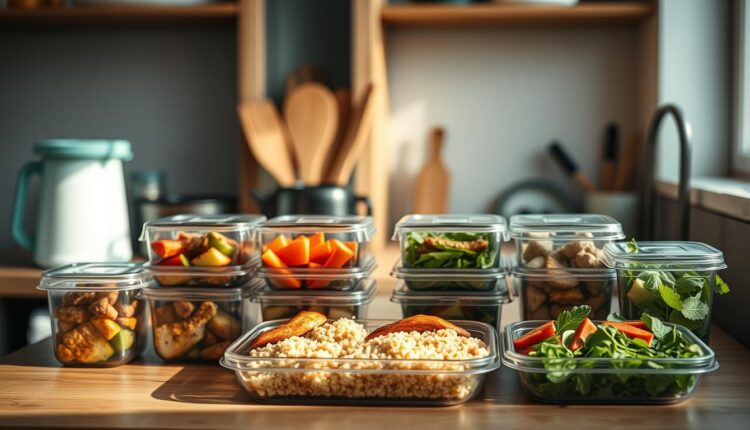Meal Prep For Work Balanced Macros For Nutrition Goals
Master meal prep for work balanced macros with our ultimate guide. Learn how to prep nutritious meals that meet your dietary goals and fit your busy schedule.
I still remember the chaotic evenings when my kitchen looked like a tornado hit it—pots boiling over, hungry kids asking “what’s for dinner?” every 90 seconds, and zero energy left to care about nutrition. Then I discovered something life-changing: strategic planning of proteins and flavor boosters.
This guide isn’t about rigid recipes or Instagram-worthy containers. It’s about creating a rhythm that turns hectic weeknights into smooth, nourishing experiences. By focusing on core elements like batch-cooked chicken or roasted veggies—paired with versatile sauces—you’ll build a foundation for countless combinations.
Think of it as your kitchen safety net. When you prep these basics ahead, you’re not just saving time. You’re ensuring every bite supports your energy levels without sacrificing taste. (Trust me—my sesame-ginger tofu bowls prove healthy can be crave-worthy.)
- Transform chaotic evenings with 2-3 prepped proteins + 1-2 sauces
- Customize dishes daily while hitting nutrition targets effortlessly
Balanced Macro Meal Prep for Work
Picture this: You’re halfway through a Wednesday meeting, stomach growling, and your only option is a vending machine snack. Been there? That’s why I started building meals around three simple pillars—proteins, carbs, and fats—to keep energy steady and cravings at bay. Balanced macro planning isn’t about rigid math. It’s designing plates that fuel your day without last-minute stress.
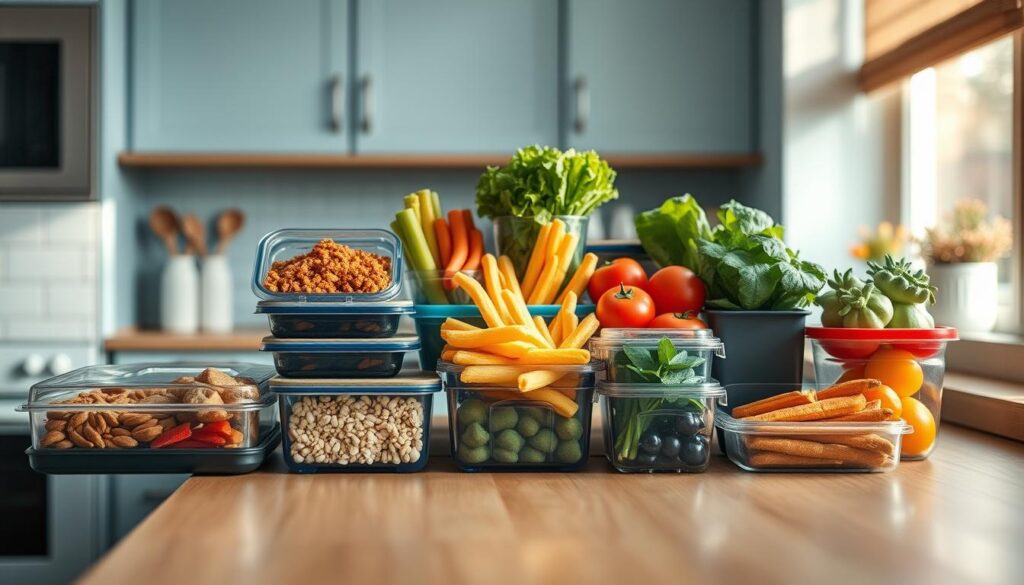
Overview of Macro Counting and Nutrition Goals
Macros—short for macronutrients—are the building blocks of every dish. Proteins repair muscles, carbs power your brain, and fats keep you satisfied. One client told me, “Tracking these three changed my 3 p.m. slump into productive hours.” Here’s the secret: balance, not perfection.
| Macronutrient | Role | Examples |
|---|---|---|
| Protein | Muscle repair & immune support | Chicken, lentils, Greek yogurt |
| Carbs | Immediate energy | Quinoa, berries, sweet potatoes |
| Fats | Hormone balance & fullness | Avocado, almonds, olive oil |
Planning ahead lets you mix these elements like a playlist. Grill chicken on Sunday? Pair it with roasted veggies Monday, toss into a wrap Tuesday, or layer over grains Wednesday. Customizable templates save time and prevent “What’s for lunch?” panic.
Take Jen, a nurse I worked with. By prepping two proteins and a sauce each week, she cut her kitchen time by 40%—and finally stopped buying soggy cafeteria salads. Her tip? “Double the quinoa. It works in bowls, stir-fries, or even breakfast.”
Understanding Macros and Their Role in Nutrition
Ever notice how some lunches leave you buzzing with energy while others make you eye the office coffee pot by 2 p.m.? The difference often comes down to three nutritional powerhouses working behind the scenes. Let’s break down how these unsung heroes fuel your body and sharpen your focus.
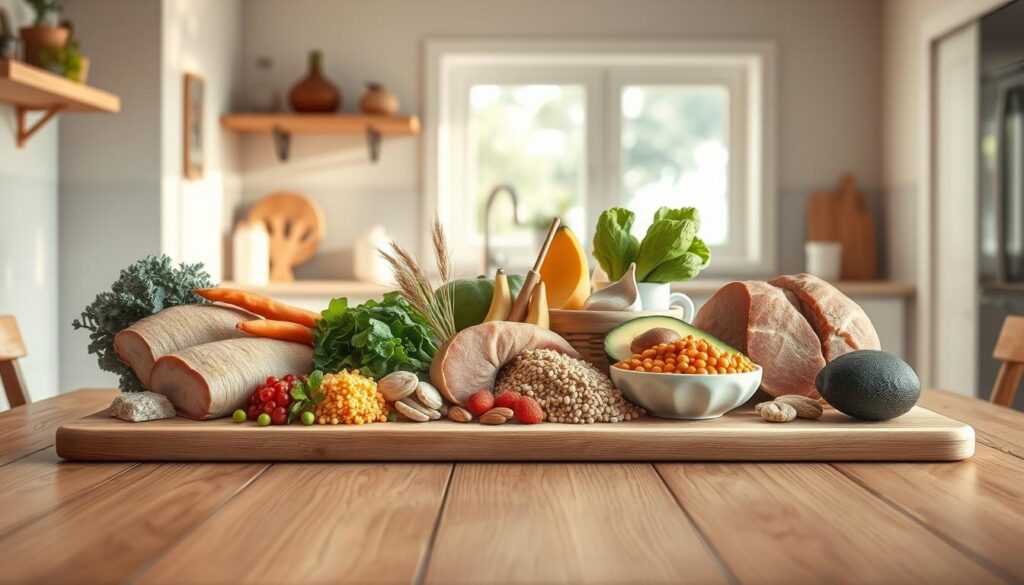
Macros Explained: Proteins, Carbs, and Fats
Think of your body as a high-performance vehicle. Proteins act like mechanics—repairing muscle tissue after workouts. Carbs are premium fuel, converting to glucose for instant energy. Fats? They’re your shock absorbers, keeping joints lubricated and hunger signals calm.
| Macro | Body’s Use | Everyday Comparison |
|---|---|---|
| Protein | Rebuilds cells | Like patching potholes in a road |
| Carbs | Powers movement | Gasoline for your morning commute |
| Fats | Protects organs | Weatherproofing a house |
How Macros Impact Daily Energy and Work Performance
When graphic designer Marco switched from carb-heavy lunches to balanced plates, he told me, “I stopped needing three espresso shots to survive client meetings.” Here’s why: proteins slow digestion, carbs spike alertness, and fats maintain steady blood sugar. Together, they create sustained energy without crashes.
Aim for this combo in your food containers: grilled chicken (protein), wild rice (carbs), and avocado slices (fats). This trio keeps your brain fed during back-to-back Zoom calls while supporting physical recovery after gym sessions.
Meal Prep For Work Balanced Macros: Effective Strategies
Last Tuesday, my neighbor texted me a photo of her fridge—packed with identical containers of plain chicken breasts. “Help,” she wrote. “I can’t eat this all week!” Her struggle? Missing the flavor and flexibility that turns basic ingredients into crave-worthy lunches. Let’s fix that.
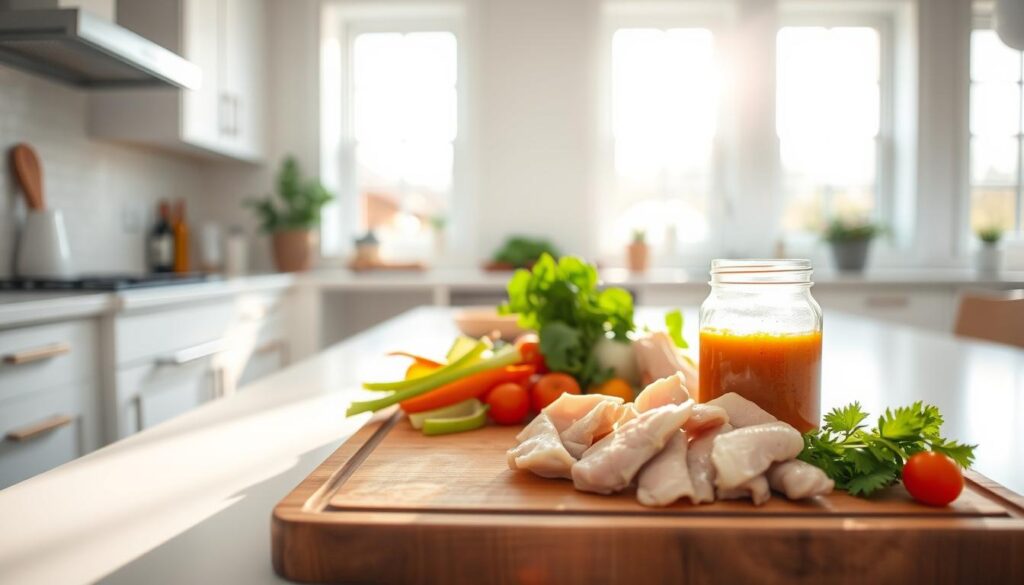
Tips for Protein and Sauce Preparation
Rotisserie chicken saved my sanity during tax season. Shred it Sunday night, then pair with homemade sauces that transform leftovers. Try this combo: batch-grill two proteins (like turkey patties and lemon-pepper shrimp) alongside 1-2 zesty dressings.
| Protein | Prep Method | Sauce Pairing |
|---|---|---|
| Chicken thighs | Sheet pan roast | Yogurt-dill |
| Ground beef | Skillet crumble | Smoky BBQ |
| Tempeh | Marinate & bake | Peanut-lime |
Store sauces in squeeze bottles for easy drizzle control. A client once joked, “Your cilantro-jalapeño crema makes desk lunches feel like takeout.” Mission accomplished.
Portion Control for Optimal Nutrient Balance
Use muffin tins to pre-portion sauces—each compartment holds ~2 tbsp. For proteins, visualize deck-of-card sizes. Here’s how I balance containers:
| Component | Portion Guide | Tool |
|---|---|---|
| Proteins | Palm-sized | Kitchen scale |
| Grains | ½ baseball | Measuring cup |
| Veggies | Unlimited* | Your biggest bowl |
*Within reason—no one needs 3 cups of raw kale at noon. Mix roasted and raw veggies for texture variety without macro overload.
Essential Tools and Equipment for Meal Prepping
Three years ago, I spilled an entire batch of chili in my car because my container lid popped open. That’s when I realized: good gear matters as much as good recipes. The right tools turn chaotic kitchen sessions into streamlined systems. Let’s explore the essentials that keep ingredients fresh and prep days stress-free.
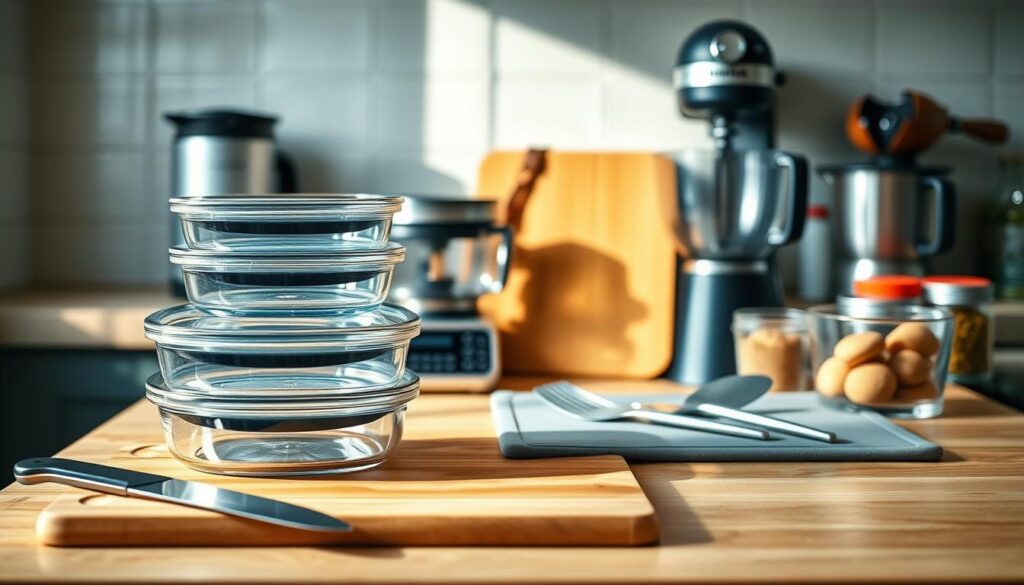
Meal Prep Containers and Storage Options
Leak-proof containers are non-negotiable. Look for glass varieties with locking lids—they’re microwave-safe and won’t absorb odors. For portion control, compartmentalized bento boxes work wonders. A client once shared, “Switching to stackable containers freed up half my fridge space!”
| Container Type | Best For | Pro Tip |
|---|---|---|
| Glass with dividers | Complete meals | Freezer-to-oven safe |
| Silicone pouches | Sauces & dressings | Reusable + dishwasher-friendly |
| Mason jars | Layered salads | Prevent sogginess |
Kitchen Gadgets and Time-Saving Tools
An immersion blender whips sauces in seconds. A mandoline slicer? It turns 10 minutes of chopping into 30 seconds. These aren’t luxuries—they’re game-changers for efficient planning.
| Tool | Purpose | Time Saved |
|---|---|---|
| Digital scale | Portion accuracy | 3 mins/day |
| Vegetable chopper | Uniform cuts | 8 mins/meal |
| Silicone baking mats | Zero-cleanup roasting | 15 mins/week |
Organize your space with drawer dividers for utensils and wall hooks for measuring cups. A $20 investment here can save hours of searching during busy mornings. As my friend Carlos says, “A labeled spice rack is the unsung hero of my kitchen.”
Choosing Lean Proteins and Key Ingredients
That sizzle when salmon hits the pan? That’s the sound of your energy levels getting ready to soar. Building satisfying containers starts with smart protein choices and their perfect partners. Let’s explore how to mix textures and flavors while keeping nutrition locked in.
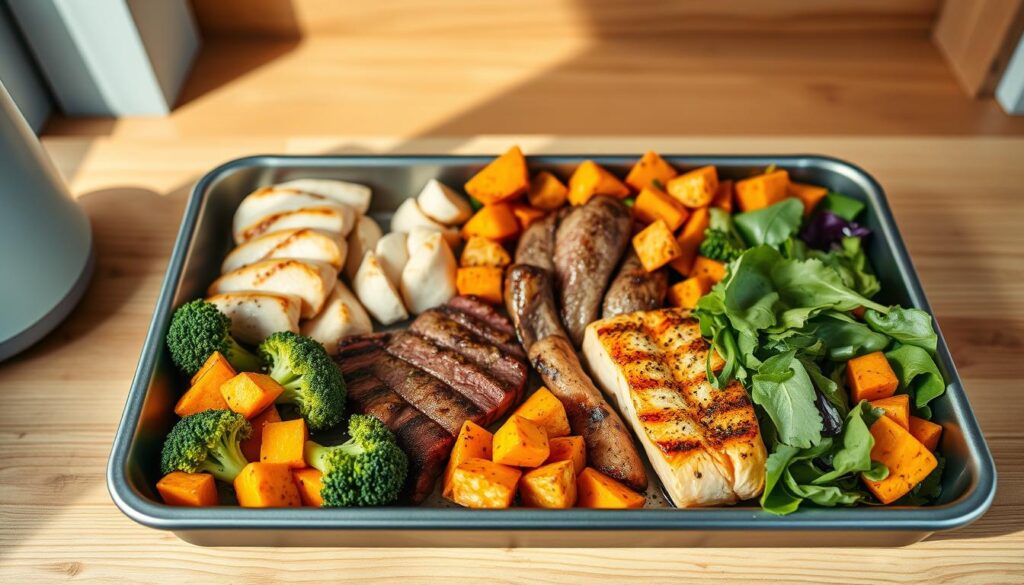
Protein Powerhouses for Lasting Fuel
Rotate these four staples to avoid taste bud burnout:
| Protein | Prep Hack | Perfect Pair |
|---|---|---|
| Chicken thighs | Marinate in Greek yogurt | Roasted broccoli |
| Ground turkey | Season with smoked paprika | Quinoa pilaf |
| Flank steak | Slice against the grain | Pepper stir-fry |
| Salmon | Glaze with miso | Farro salad |
Baked sweet potatoes work overtime. Mash them into turkey burgers or cube for grain bowls. One client raves, “Roasting a batch Sundays makes my lunches feel decadent—without the guilt.”
Veggie Variety Made Simple
Rainbow produce isn’t just pretty. Purple cabbage fights inflammation. Orange bell peppers boost immunity. Try this weekly formula:
• Roasted: Brussels sprouts + carrots
• Raw: Snap peas + radishes
• Fermented: Kimchi or sauerkraut
My freezer secret? Keep frozen edamame for last-minute protein boosts. Toss into fried rice or blend into dips.
Rotate your proteins like favorite playlists—grilled chicken Monday, turkey chili Wednesday, salmon Friday. “Switching up my base ingredients keeps takeout temptation away,” shares a teacher I coached. Remember: Spices are calorie-free flavor magic. Cumin transforms beef. Dill elevates fish. Your containers should excite you—not feel like chores.
Planning Your Weekly Meal Schedule
Ever stood frozen in the grocery aisle, staring at your list while your cart blocks traffic? I’ve been there too—until I discovered the magic of strategic scheduling. A well-crafted plan turns chaotic shopping trips into smooth, 20-minute missions.

Creating an Effective Meal Prep Calendar
Start by assigning dishes to days based on your energy levels. Mondays call for simple grill-and-go proteins. Wednesdays? Try sheet pan dinners. Here’s a sample framework:
| Day | Focus | Task |
|---|---|---|
| Sunday | Batch cooking | Roast veggies, cook grains |
| Tuesday | Quick assembly | Build bowls with prepped ingredients |
| Thursday | Repurpose leftovers | Transform chicken into wraps or salads |
One client shared, “Theme nights like ‘Stir-Fry Fridays’ make planning feel fun, not forced.” Use sticky notes to swap meals visually before finalizing.
Organizing Your Grocery List by Sections
Group items by store layout: produce first, proteins last. This prevents zigzagging between aisles. Try this template:
- Produce: Spinach, bell peppers, snap peas
- Dry goods: Quinoa, canned beans, spices
- Dairy: Greek yogurt, shredded cheese
A teacher I coached saves 15 minutes weekly by color-coding her list—highlighting pantry staples in yellow, fridge items in green. “It’s like a treasure map for hungry people,” she laughs.
Schedule a Sunday reset: 30 minutes to wash produce, portion snacks, and review your healthy lunch combinations. Consistency builds momentum—you’ll spend less time deciding and more time thriving.
Quick and Easy Macro-Friendly Meal Prep Recipes
A client once texted me a photo of her lunch—grilled shrimp over zucchini noodles with peanut sauce. “First time I’ve looked forward to desk dining,” she wrote. That’s the magic of recipes designed for both flavor and function. Let’s explore combos that turn basic ingredients into lunchbox stars.
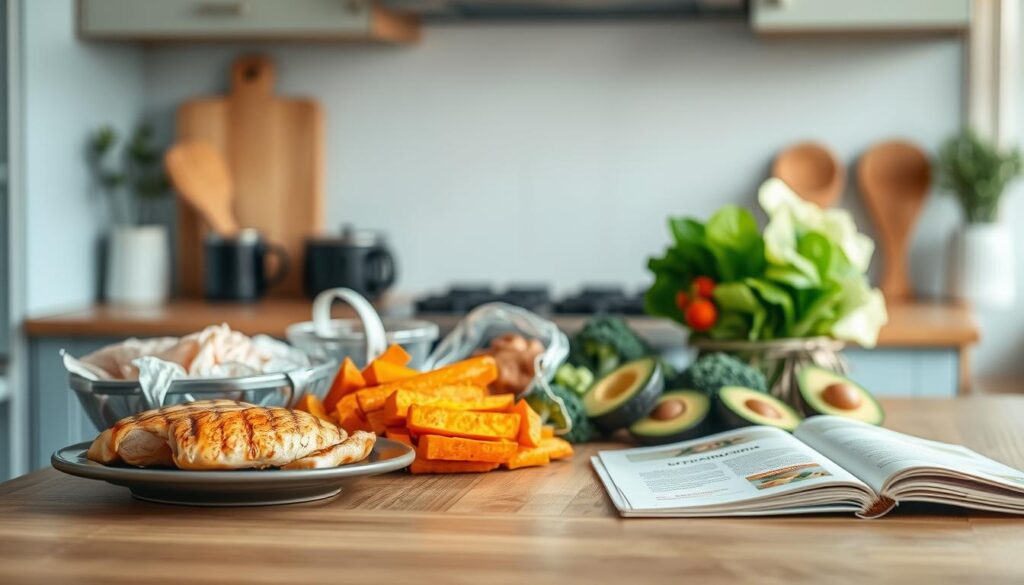
One-Pot Wonders & Speedy Skewers
Turkey-veggie stir-fry cooks faster than takeout arrives. Toss ground turkey with bell peppers and snap peas in sesame oil. Add pre-cooked quinoa for a 15-minute feast. For kebabs, alternate chicken-apple sausage cubes with pineapple chunks—grill or broil 8 minutes.
| Base | Add-Ins | Sauce |
|---|---|---|
| Cauliflower rice | Shrimp + edamame | Ginger-lime |
| Whole wheat pasta | Salmon + spinach | Lemon-dill |
Bold Bowls & Pita Creations
Greek quinoa bowls need three components: lemon-herb grains, roasted chickpeas, and tzatziki. Stuff into pitas with shredded lettuce for crunch. One dad in my program raves, “My kids think they’re eating fancy street food—I know they’re getting veggies.”
Dietary-Inclusive Options
Swap chicken for baked tofu in coconut curry. Use spiralized sweet potatoes instead of noodles. Need gluten-free? Try these combos:
- Vegan: Lentil-walnut taco meat in lettuce cups
- Paleo: Egg roll bowls with ground pork
- Nut-free: Sunflower seed pesto zucchini boats
Batch-cook components like make-ahead breakfasts to mix into lunch bowls. Remember: Balanced plates shouldn’t mean bland plates. A sprinkle of smoked paprika or squeeze of lime transforms leftovers into something special.
Creating Delicious Homemade Sauces and Dressings
Ever opened your lunchbox to find another dry chicken breast staring back? That changed for me when I discovered sauces aren’t just toppings—they’re flavor rescuers. A well-crafted dressing turns basic ingredients into vibrant combinations while keeping nutrition goals intact.
Macro-Friendly Sauce Recipes to Elevate Your Meals
Store-bought versions often hide sugar bombs. Homemade lets you control every component. Try these bases:
| Base | Flavor Boosters | Best With |
|---|---|---|
| Greek yogurt | Garlic + dill + lemon | Grilled proteins |
| Tahini | Maple syrup + apple cider vinegar | Grain bowls |
| Avocado | Cilantro + lime + jalapeño | Taco salads |
Prep dressings in mason jars—shake and pour. One teacher in my program stores hers in squeeze bottles: “A zigzag of spicy yogurt sauce makes roasted veggies disappear from my kids’ plates.”
For freshness, freeze herb-based sauces in ice cube trays. Thaw overnight or microwave for 15 seconds. Remember: Bold flavors needn’t derail macros. A tablespoon of toasted sesame seeds adds crunch without calorie overload.
Your secret weapon? Citrus zest. It brightens dressings without oil. Rotate three staple sauces weekly to keep taste buds guessing—your containers will never feel repetitive.
Incorporating Batch Cooking for Efficiency
Three weeks into my new job, I burned a pot of quinoa while scrambling to answer work emails. That’s when I embraced batch cooking—the art of cooking once to eat well all week. This method turns Sunday afternoons into strategic sessions where proteins and grains become building blocks for endless combinations.
Batch Cooking Proteins and Carbohydrate Layers
Start with versatile foundations. Shredded chicken breasts work in tacos, salads, or soups. Roast two sheet pans of veggies—broccoli and bell peppers hold up well. Pair these with carb bases like:
- Jasmine rice (cooks in 15 minutes)
- Quinoa (adds complete protein)
- Roasted sweet potatoes (natural sweetness balances spices)
Use a slow cooker for hands-off prep. A teacher in my program swears by her “set-it-and-forget-it pulled pork” that becomes tacos, sandwiches, or pizza toppings. Here’s her favorite combo:
| Protein | Carb Pairing | Storage Tip |
|---|---|---|
| Shredded beef | Mashed cauliflower | Freeze in muffin tins |
| Lemon-herb tofu | Brown rice | Portion with ice cream scoop |
Store cooked foods in airtight glass containers. Grains stay fresh 4 days; proteins freeze well for 3 months. Label everything—future-you will thank past-you during hectic mornings.
One-tray recipes simplify cleanup. Toss salmon fillets with asparagus and baby potatoes—roast at 425°F for 20 minutes. “This method cut my kitchen time in half,” shares a dad who meal preps during soccer practice breaks.
Batch cooking isn’t about eating the same dish repeatedly. It’s creating a flavor toolkit that lets you assemble nourishing plates in minutes—no burnt grains required.
Tips for Balancing Carbs, Fats, and Proteins
Ever stared at your lunchbox feeling unsatisfied despite a full container? The culprit might be unbalanced ratios. Balancing these three elements isn’t about strict math—it’s creating harmony between energy sources. Think of it like adjusting a thermostat: small tweaks create big comfort.
Macro Adjustments for Different Meal Types
Breakfast needs quick energy. Pair oats (carbs) with almond butter (fats) and Greek yogurt (protein). For post-workout meals, boost protein with turkey lettuce wraps and avocado slices. Try these swaps:
| Meal Type | Carb Focus | Protein Source | Fat Addition |
|---|---|---|---|
| Lunch | Wild rice | Grilled shrimp | Olive oil drizzle |
| Snack | Apple slices | String cheese | Walnut halves |
| Dinner | Roasted peppers | Ground turkey | Pesto swirl |
Tracking Nutrient Intake for Consistent Results
Apps like MyFitnessPal simplify tracking. Scan barcodes or create custom recipes. One client shared, “Seeing my fat intake spike on pizza nights made me add roasted veggies to balance it out.”
Try these steps:
- Weigh ground meats raw for accuracy
- Use measuring spoons for oils and nut butters
- Batch-log repetitive meals
Swap 80/20 ground beef for 93% lean turkey in chili—it cuts saturated fat while keeping flavor. A teacher in my program doubled her afternoon energy by adding chickpeas to salads. “Now I power through parent conferences without caffeine crashes,” she says.
Navigating Time Constraints: Meal Prep for Busy Professionals
Between back-to-back Zoom calls and school pickup lines, cooking often feels like a luxury. But what if you could reclaim 90 minutes weekly? Strategic planning turns chaotic evenings into grab-and-go victories. The key: working smarter, not harder.
Time-Saving Meal Prep Hacks for a Hectic Schedule
Start with ingredient prep during downtime. Wash greens while waiting for coffee. Chop veggies during podcast listening. One client—a lawyer—preps her entire week’s snacks during Sunday football commercials. “Ninety seconds of effort during ads adds up to two hours saved,” she says.
Streamline recipes with these swaps:
| Time-Consuming Task | Hack | Saved Weekly |
|---|---|---|
| Chopping onions | Pre-diced frozen | 22 minutes |
| Cooking grains | Microwave pouches | 35 minutes |
| Portioning snacks | Reusable silicone bags | 18 minutes |
Freeze single servings of chili or stew in muffin tins. Pop out frozen “pucks” into containers—they thaw by lunch. A nurse I coach stores six rotating sauces in her freezer. “Thai peanut one day, pesto the next—variety without daily cooking,” she explains.
Invest 45 minutes upfront to:
- Roast two sheet pans of mixed veggies
- Hard-boil a dozen eggs
- Cook three chicken breasts in the slow cooker
These staples become salads, wraps, or grain bowls in minutes. As one teacher shared, “Pre-chopped broccoli florets are my weekday superheroes.” Small efforts compound—like depositing time into a culinary savings account.
Freezing and Storing Prepped Meals Safely
When my freezer turned into an ice cave of mystery containers last winter, I realized: smart storage makes or breaks meal success. Proper techniques preserve flavors and nutrients while preventing “freezer surprise” disappointments.
Proper Storage Techniques to Preserve Freshness
Air is the enemy. Remove excess oxygen using vacuum sealers or squeeze-out bags. For roasted potatoes and similar starches:
- Cool completely before sealing
- Layer between parchment paper to prevent clumping
- Mark dates with freezer-safe tape
| Container Type | Best For | Max Storage |
|---|---|---|
| Silicone bags | Soups & sauces | 3 months |
| Glass jars | Layered grains | 2 months |
| Aluminum trays | Casseroles | 4 months |
Maximizing Shelf Life with Smart Freezing Tips
Blanch veggies like green beans before freezing to lock in color. For sweet potatoes:
- Roast until tender
- Mash with a splash of broth
- Portion into muffin tins
Thaw proteins overnight in the fridge—never on counters. Reheat roasted potatoes in air fryers to restore crispness. “Freezing individual portions lets me grab exactly what I need,” shares a mom who preps during naptime.
Utilizing Meal Prep Subscriptions and Resources
When my client Sarah—a pediatric nurse and mom of twins—told me she’d cracked the code to stress-free dinners, I expected a complex system. Instead, she showed me her phone: “These apps do the heavy lifting so I can focus on feeding my crew.” Modern meal services aren’t one-size-fits-all. They’re customizable allies in your kitchen journey.
Customizing Your Meal Plan to Fit Your Lifestyle
Top services like Prep Dish and Real Plans let you filter recipes by dietary needs, cooking time, and even ingredient preferences. Gluten-free? Vegan? Picky eaters? Checkboxes adjust your weekly lineup instantly. One dad in my program raves, “The app swaps chickpeas for chicken in my curry bowl—no extra thinking required.”
These platforms auto-generate shopping lists sorted by grocery aisle. No more circling the store for forgotten spices. Bonus: many sync with Instacart for curbside pickup. “Sunday planning now takes 10 minutes instead of an hour,” shares a teacher using PlateJoy.
Top Online Resources and Subscription Services
Compare features to find your match:
| Service | Best For | Standout Feature |
|---|---|---|
| Cook Once Eat All Week | Budget-focused families | 5 base ingredients = 3 meals |
| Fit Men Cook | Macro trackers | Calorie-controlled combos |
| Green Chef | Organic enthusiasts | Pre-portioned keto kits |
Most offer free trials—perfect for testing without commitment. Rotate services seasonally to keep lunches exciting. As Sarah says, “Discovering new flavor profiles through subscriptions made Tuesday tacos feel gourmet.”
Whether you need dairy-free swaps or 20-minute dinners, these tools adapt to your rhythm. Start with one plan this week. Your future self—sipping coffee while lunches magically assemble—will thank you.
Remember that first lunchbox you packed with care? That same excitement grows when you build meals around flavorful foundations instead of rigid rules. Batch-roasted chicken thighs become tacos on Tuesday and curry bowls by Thursday. Ground turkey morphs into chili or lettuce wraps. Every ingredient works overtime.
Balanced nutrition thrives on simplicity. Roast extra sweet potatoes for grain bowls and breakfast hashes. Keep avocado slices handy to upgrade salads or rice cakes. These small choices create big wins—steady energy through meetings and post-workout recovery without extra effort.
Want to keep momentum? Try our free 5-Day Flavor Reset for sauce recipes and storage hacks. One reader transformed leftover rotisserie chicken into buffalo-style wraps her kids now request weekly. “It’s not about perfection,” she says. “It’s finding what makes your taste buds dance.”
Your journey starts where you are. Swap fries for roasted peppers in that steak bowl. Toss feta cheese into quinoa salads. Every tweak builds confidence. Because nourishing routines shouldn’t feel like chores—they’re invitations to savor life, one delicious container at a time.
Savory Lemon-Herb Chicken Meal Prep Bowls
A vibrant and nutritious meal prep solution featuring tender lemon-herb chicken paired with roasted vegetables and fluffy brown rice. Perfect for busy weekdays, these bowls offer a balanced combination of protein, fiber, and flavor to keep you energized throughout the day.
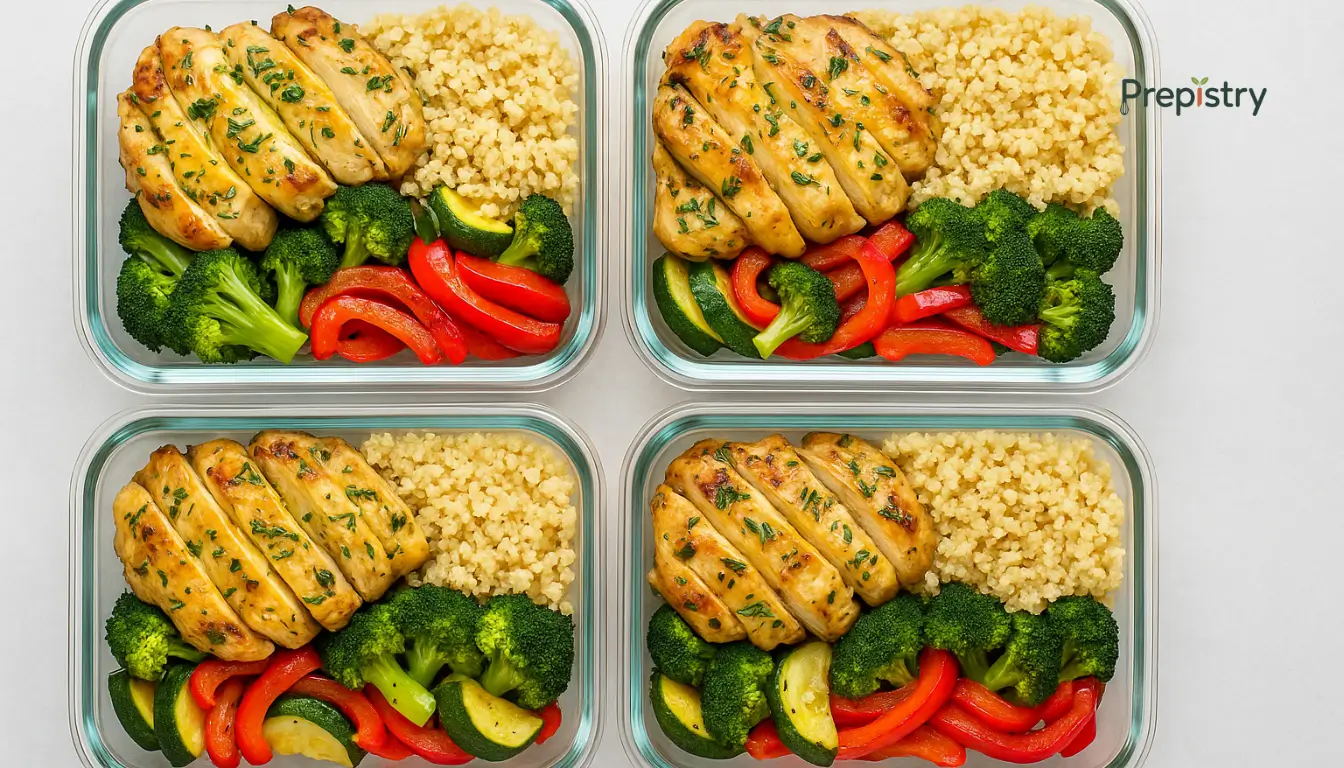
Nutrition Information
Equipment Needed
- Baking sheet
- Mixing bowls
- Measuring cups and spoons
- Chef's knife
- Cutting board
Ingredients
-
4 boneless, skinless chicken breasts
-
2 tablespoons olive oil
-
2 lemons, juiced and zested
-
2 teaspoons dried oregano
-
1 teaspoon garlic powder
-
1 teaspoon salt
-
1/2 teaspoon black pepper
-
2 cups broccoli florets
-
1 red bell pepper, sliced
-
1 yellow bell pepper, sliced
-
1 zucchini, sliced
-
2 cups cooked brown rice
-
Fresh parsley, chopped (for garnish)
Instructions
Recipe Video
Savory Lemon-Herb Chicken Meal Prep Bowls
Learn how to prepare these delicious and healthy lemon-herb chicken meal prep bowls, perfect for your weekly lunch routine.

